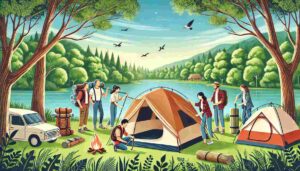When it comes to camping, there’s something undeniably enchanting about escaping the crowds, finding a secluded spot in nature, and immersing yourself in the great outdoors. Dispersed camping, also known as boondocking or wild camping, offers precisely that experience. It allows you to disconnect from the hustle and bustle of campgrounds and experience the tranquility of the wilderness.
Throughout this guide, we will dive deep into dispersed camping covering everything worth knowing to help you embark on your own adventure.
What is Dispersed Camping?
Dispersed camping refers to camping in the United States on public land that is not specifically designated as formal campsites. This style of camping is most commonly practiced in national forests and on Bureau of Land Management (BLM) land. Unlike designated campsites, which often provide amenities like trash disposal, toilet facilities, tables, and fire pits, dispersed camping locations do not offer such services. You essentially become your own campground host, responsible for everything from setting up your campsite to disposing of waste properly.
While dispersed camping occurs on public land, each managing agency has its own set of regulations governing it, typically emphasizing adherence to Leave No Trace principles. Additionally, some public lands may impose a 14-day camping limit. This type of camping is also known by other terms such as boondocking, dry camping, or wild camping.
The Attraction of Dispersed Camping
- Solitude and Serenity: One of the primary draws of dispersed camping is the solitude it offers. You can find remote spots far from the crowds, where the only sounds you hear are those of nature. It’s an excellent way to escape the noise of everyday life and find peace in the wilderness.
- Cost Savings: Dispersed camping is often free, making it an affordable option for outdoor enthusiasts. You won’t have to pay campsite fees, which can add up, especially on longer trips.
- Flexibility and Adventure: With dispersed camping, you have the flexibility to choose where you camp. Whether it’s by a serene lake, in a dense forest, or on a mountainside, you can tailor your camping experience to your preferences. It’s an adventurous way to explore new areas and discover hidden gems.
- Connection with Nature: Being surrounded by untouched nature can be a transformative experience. Dispersed camping allows you to forge a deeper connection with the environment, fostering an appreciation for the natural world.
Where Can You Dispersed Camp?
To enjoy dispersed camping, you need to know where it’s permitted. The following types of public lands are typically open to dispersed camping:
- National Forests: Many national forests in the United States offer dispersed camping opportunities. You can generally camp anywhere within the forest, as long as you follow specific regulations and guidelines.
- Bureau of Land Management (BLM) Land: BLM land is another great option for dispersed camping. Similar to national forests, you can often camp on BLM land as long as you adhere to the rules.
- National Grasslands: Some areas managed by the U.S. Forest Service, known as national grasslands, also permit dispersed camping.
- Wilderness Areas: Wilderness areas are protected lands with limited human impact. While they provide a pristine camping experience, regulations can be stricter. Check with the managing agency for specific rules.
- State Trust Lands: In some states, you can disperse camp on state trust lands. Regulations vary by state, so it’s essential to research the rules for your chosen location.
- Desert and Arid Regions: Dispersed camping is often allowed in deserts and arid regions, but water availability can be a concern, so plan accordingly.
Always check with the managing agency for the specific rules and regulations of the area you plan to visit. Some locations may have restrictions, seasonal closures, or permit requirements.
Preparing for Dispersed Camping
Before embarking on a dispersed camping trip, there are several crucial steps you should take to ensure a safe and enjoyable experience:
1. Research Your Destination
Thoroughly research the area where you plan to disperse camp. Look for information on regulations, road conditions, and any seasonal closures. Check if there are fire restrictions, wildlife concerns, or other factors to be aware of.
2. Obtain the Necessary Permits
While many dispersed camping areas do not require permits, some might. Check with the managing agency to determine if you need any permits or passes to camp legally.
3. Plan Your Route
Map out your route to your chosen campsite and have backup options in case your preferred spot is occupied or inaccessible. Ensure that your vehicle is suitable for the terrain, especially if you plan to venture off-road.
4. Pack Appropriately
Pack all the necessary gear and supplies, including food, water, camping equipment, and safety gear. Ensure you have a first-aid kit and are prepared for changing weather conditions.
5. Leave No Trace
Follow Leave No Trace principles, which include packing out all trash, using established fire rings or stoves, and practicing responsible bathroom habits. Leave the environment as you found it to preserve it for future generations.
Setting Up Camp
Once you’ve reached your chosen dispersed camping location, it’s time to set up camp. Here are some tips to ensure you do it right:
1. Choose a Suitable Campsite
Select a flat and level spot away from water sources, trails, and fragile vegetation. Follow any posted signs or guidelines regarding where you can camp.
2. Campfire Safety
If fires are allowed, use a designated fire ring or bring a portable camp stove. Keep your fire small, and always have a way to extinguish it quickly.
3. Food Storage
Properly store your food to avoid attracting wildlife. Use bear canisters or hang your food in a bear bag away from your campsite.
4. Waste Disposal
Dispose of waste properly by burying human waste in a “cathole” at least 6-8 inches deep and 200 feet away from water sources. Pack out used toilet paper and feminine hygiene products in a sealable bag.
5. Leave No Trace
Remember to leave no trace of your presence. This means packing out all trash, including small scraps of litter, and leaving the environment as pristine as possible.
Safety Considerations
Safety should be a top priority during any camping trip, and dispersed camping is no exception. Here are some safety considerations to keep in mind:
1. Wildlife Awareness
Learn about the wildlife in the area and how to safely coexist with it. Store food properly to avoid attracting bears or other wildlife.
2. Emergency Communication
Ensure you have a reliable means of communication, such as a satellite phone or a personal locator beacon (PLB), in case of emergencies. Cell phone coverage can be limited in remote areas.
3. Weather Preparedness
Stay informed about the weather forecast for your camping area and be prepared for changing conditions. Dress in layers and have adequate shelter in case of unexpected rain or cold temperatures.
4. Navigation
Carry maps, a compass, or a GPS device to help you navigate the terrain. Familiarize yourself with the area before heading out, and let someone know your itinerary in case of an emergency.
Leave No Trace Principles
Leave No Trace (LNT) is a set of outdoor ethics that promotes responsible outdoor recreation. Here are the seven principles of LNT and how they apply to dispersed camping:
- Plan Ahead and Prepare: Research your destination, obtain permits if necessary, and plan your route. By being well-prepared, you can minimize your impact on the environment.
- Travel and Camp on Durable Surfaces: Camp on established campsites or on surfaces that are resistant to impact, such as rock or gravel. Avoid trampling on fragile vegetation.
- Dispose of Waste Properly: Follow Leave No Trace guidelines for disposing of waste, including human waste. Pack out all trash, and leave the area cleaner than you found it.
- Leave What You Find: Do not disturb or remove plants, rocks, or historical and cultural artifacts. Leave natural and cultural features as you found them.
- Minimize Campfire Impact: Use a camp stove for cooking instead of making fires. If fires are allowed, use established fire rings and keep fires small.
- Respect Wildlife: Observe wildlife from a distance and do not feed them. Store food securely to prevent wildlife from becoming habituated to human food.
- Be Considerate of Other Visitors: Keep noise levels down, yield the trail to others, and maintain a friendly and respectful attitude toward fellow campers.
By following these principles, you can minimize your impact on the environment and help preserve the beauty of the wilderness for future generations.
Common Misconceptions about Dispersed Camping
There are several misconceptions about dispersed camping that need to be addressed:
1. Dispersed Camping is Always Free
While many dispersed camping areas do not charge campsite fees, there may still be permit fees or other associated costs. Always check with the managing agency for any fees or requirements.
2. You Can Camp Anywhere
While dispersed camping offers more flexibility in choosing your campsite, there are still regulations and guidelines to follow. Camp only in designated areas or follow specific rules for the location you choose.
3. You Don’t Need to Plan Ahead
Planning is crucial for a successful dispersed camping trip. Research the area, check for permits, and have a well-thought-out itinerary to ensure a safe and enjoyable experience.
4. Leave No Trace Doesn’t Apply
Leave No Trace principles apply to all outdoor activities, including dispersed camping. It’s essential to follow these guidelines to protect the environment and minimize your impact.
Dispersed Camping Gear and Essentials
To have a successful dispersed camping trip, you’ll need the right gear and essentials. Here’s a checklist of items to consider packing:
Camping Gear
- Tent or Shelter: Choose a reliable and weather-appropriate shelter.
- Sleeping Bag and Pad: Ensure your sleeping bag is suitable for the expected temperatures, and use a sleeping pad for insulation and comfort.
- Cooking Equipment: Pack a camp stove, cookware, utensils, and a lighter or matches.
- Water Filtration: Carry a water filter or purification method to ensure a safe drinking water source.
- Navigation Tools: Have maps, a compass, or a GPS device to help you navigate the area.
Clothing
- Layered Clothing: Dress in layers to adapt to changing weather conditions.
- Rain Gear: Carry a waterproof jacket and pants in case of rain.
- Warm Clothing: Include insulated clothing for cold nights.
- Hiking Boots: Choose comfortable, sturdy hiking boots suitable for the terrain.
Food and Water
- Non-Perishable Food: Pack lightweight, easy-to-prepare meals and snacks.
- Water Containers: Carry enough water containers to meet your hydration needs.
Safety and First Aid
- First Aid Kit: Include essential first-aid supplies for minor injuries.
- Emergency Communication: Carry a satellite phone, PLB, or other emergency communication device.
- Knife or Multi-tool: A versatile tool can be invaluable in various situations.
Miscellaneous
- Trash Bags: Pack out all trash and litter.
- Insect Repellent: Protect yourself from mosquitoes and other insects.
- Sun Protection: Use sunscreen, sunglasses, and a wide-brimmed hat to shield yourself from the sun.
- Personal Hygiene Items: Bring toiletries and biodegradable soap for responsible cleaning.
Find these items on Amazon here.
Remember that your gear choices should be tailored to the specific conditions and environment of your camping destination.
Tips for a Great Dispersed Camping Experience
Here are some additional tips to enhance your dispersed camping adventure:
1. Be Self-Reliant
Dispersed camping requires self-sufficiency. Be prepared to handle unexpected situations, including adverse weather or emergencies, without relying on immediate assistance.
2. Respect Quiet Hours
Part of the appeal of dispersed camping is the peace and quiet of nature. Be mindful of noise levels, especially during designated quiet hours.
3. Embrace Minimalism
Simplify your camping experience by packing only the essentials. Leave unnecessary items at home to reduce clutter and make your trip more enjoyable.
4. Learn Basic Outdoor Skills
Before heading out, acquire essential outdoor skills such as navigation, fire-building, and first aid. Knowing how to handle common camping challenges will boost your confidence and safety.
5. Share Your Plans
Inform a trusted friend or family member about your trip itinerary, including your location and expected return date. This information can be vital in case of emergencies.
6. Practice Fire Safety
If campfires are allowed, follow fire safety guidelines meticulously. Keep fires small, use existing fire rings, and never leave a fire unattended.
7. Observe Wildlife Ethically
While observing wildlife can be a thrilling part of camping, do so from a safe distance and without disturbing the animals. Do not feed wildlife or leave food unattended.
8. Leave a Review
After your dispersed camping trip, consider leaving a review or sharing your experience with the managing agency or on outdoor forums. This can help future campers make informed decisions.
Camping Options on BLM-Managed Lands
Camping on Bureau of Land Management (BLM) public lands offers a variety of experiences. You can choose from developed campgrounds with various amenities, including restrooms, water, and electrical hookups, or opt for the simplicity of dispersed camping in the backcountry. Most BLM campgrounds require fees, and reservations are available at some. Adhering to campground rules is essential, including prompt fee payment and not leaving personal property unattended.
For a more remote experience, dispersed camping is an option, with a maximum stay of 14 days within a 28-day period. Be mindful of existing sites and avoid polluting the environment. State-specific rules may apply, so check before planning your trip.
Preserve cultural sites, report any crimes, and help protect these public lands for future generations.
Conclusion
Dispersed camping offers a unique and rewarding way to experience the beauty of the natural world. It allows you to disconnect from the modern world, connect with nature, and create lasting memories. By following the guidelines, tips, and principles outlined in this comprehensive guide, you can embark on your own dispersed camping adventure with confidence and respect for the environment.
Remember that responsible camping ensures that these wild and pristine places remain unspoiled for generations to come. So, pack your gear, plan your trip, and savor the serenity of dispersed camping in the great outdoors.
Additional Resources
Here are some additional resources, including books, websites, and organizations, that can offer further information and support for your dispersed camping experience.
Books:
- “The Complete Idiot’s Guide to Camping and Hiking“ by Michael Mouland
- A comprehensive guide that covers various aspects of camping and hiking, including dispersed camping tips.
- “Camping and Woodcraft: A Handbook for Vacation Campers and for Travelers in the Wilderness“ by Horace Kephart
- A classic camping and woodcraft guide that provides valuable insights into outdoor living and camping skills.
- “Leave No Trace: A Guide to the New Wilderness Etiquette“ by Annette McGivney
- A book that delves deep into the principles of Leave No Trace ethics, crucial for responsible dispersed camping.
Websites:
- Leave No Trace Center for Outdoor Ethics (https://lnt.org)
- The official website of Leave No Trace, offers in-depth information on outdoor ethics and responsible camping practices.
- U.S. Forest Service – Dispersed Camping (https://www.fs.usda.gov/visit/know-before-you-go/camping)
- Provides information on dispersed camping regulations, tips, and guidelines on national forests and grasslands.
- Bureau of Land Management – Camping & Recreation (https://www.blm.gov/programs/recreation/camping)
- Offers resources and information on dispersed camping opportunities on BLM lands.
- The Dyrt (https://thedyrt.com)
- An online platform that allows campers to discover and review campgrounds, including dispersed camping sites.
Organizations:
- American Hiking Society (https://americanhiking.org)
- A nonprofit organization dedicated to preserving and protecting hiking trails and promoting responsible outdoor recreation.
- National Park Foundation (https://www.nationalparks.org)
- The official charity of America’s national parks, providing support and information about camping in national parks.
These resources should prove valuable in expanding your knowledge and support network as a dispersed camper. Whether you’re a beginner or an experienced outdoor enthusiast, they offer a wealth of information and guidance to enhance your camping experiences while preserving the natural environment.










